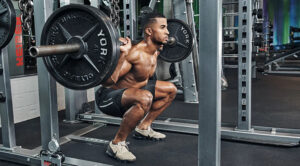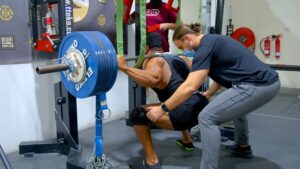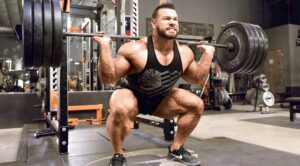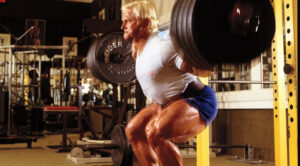The back squat movement pattern is arguably one of the most primal and critical fundamental movements necessary to improve sports performance, reduce injury risk, and support lifelong physical activity.
Based on current evidence, this first report deconstructs the technical performance of the back squat as a foundation training exercise and presents a novel dynamic screening tool that incorporates identification techniques for functional deficits that limit squat performance and injury resilience. The follow-up report will outline targeted corrective methodology for each of the functional deficits presented in the assessment tool.
The squat movement pattern is required for essential activities of daily living such as sitting, lifting, and most sporting activities. It is also a staple exercise in training regimens designed to enhance performance and build injury resilience. Despite variations on how the squat technique is instructed and executed to address specific performance goals, nearly all squat variations comprise a standard, basic, and fundamental blueprint that underlies the biomechanical technique that will support progressive physical attribute improvements and decrease the risk of training-induced injuries. In addition, the unloaded back squat (herein referred to as “back squat”) has been proposed for use as a screening tool to identify biomechanical deficits that may hinder optimal movement patterns compromising performance and injury resilience. “In particular, the back squat can be used to assess an individual for neuromuscular control, strength, stability, and mobility within the kinetic chain”.
The purpose of this commentary is to deconstruct the technical performance of the back squat and the related evidence, as both a foundation training exercise and a dynamic screening tool. “Specifically, we aim to describe common functional deficits during back squat performance known to increase injury risk during training and dynamic sport. Identified deficits and injury mechanisms will be formalized together with anatomical variations that influence squat kinematics and kinetics. In the follow-up manuscript, we aim to present detailed targeted training exercises and techniques to correct biomechanical deficits, (Part II) which are vital to improving the technical skill and competence of the back squat“. Achieving this competency is the foundation for younger individuals to partake in training progressions that enhance performance and injury resilience, and for older adults to live independently and safely.
The back squat is widely regarded as one of the most effective exercises used to enhance athletic performance as it necessitates the coordinated interaction of numerous muscle groups and strengthens the prime movers needed to support explosive athletic movements such as jumping, running, and lifting. Furthermore, back squat proficiency supports derivative squat movements that translate to many everyday tasks such as lifting and carrying heavy objects, which relates this exercise to improving quality of life. “The squat has also become more commonly used in clinical settings to strengthen lower-body musculature (especially posterior chain strength and recruitment patterns) with little to no harm on connective tissue after joint-related injury. Specifically, closed kinetic chain exercise is commonly used throughout the rehabilitation process to avoid excessive strain being placed on the anterior cruciate ligament (ACL), making the squat a favorable exercise for rehabilitation”. It is highly recommended that an individual is first able to demonstrate proficiency during bodyweight back squat performance before advancing to more intense variations and derivatives of squatting such as externally loaded squats and plyometric training.
The back squat exercise is most often prescribed with an individual starting in a standing position with the feet flat on the floor, the knees and hips in a neutral, extended anatomical position, and the spine in an upright position with preservation of its natural curves. “The squat movement begins with the descent phase as the hips, knees, and ankles flex. A common instruction is to descend until the top of the thigh is at least parallel with the ground and the hip joint is at least level with or slightly below the knee joint. Ascent is achieved primarily through the triple extension of the hips, knees, and ankles, continuing until the subject has returned to the original extended, starting position”. The posterior torso muscles, particularly the erector spinae, are recruited via isometric muscle action to support an upright posture throughout the entire squat movement. Furthermore, the posterior torso muscles are assisted by the anterior and lateral abdominal muscles to further stiffen the torso by creating tension for the abdominal wall.
There is no strength training exercise like the back squat. Hitting many muscle groups at once, the back squat requires the structures in your lower body and core to work together for optimal performance.
The back squat is a great way to build absolute strength, as it’s usually the squat variation that allows you to lift the heaviest load.
Back squats can be used to increase sporting performance or, alternatively, can be added to rehabilitation processes to strengthen muscles and joints.
How do you perform a good back squat, how can you add weight to your back squat, what muscles does the exercise work, and what are the main benefits? We answer all these questions and more below.
How to do a back squat
- Place a bar on your shoulders, generally from a rack, and step back so your feet are around shoulder-width distance.
- Your hands should grip the bar just outside your shoulders in a comfortable position. You should have a full grip around the bar.
- Point your elbows down and back, brace your core, and bend from the hips, bringing your body down.
- Keep your core engaged as you go down and make sure you don’t round your back. Your upper body should stay tall as your hips descend back and down.
- Go all the way until your hips descend lower than your knees.
- Generally, try to keep your knees in line with your toes. Your heels should stay in contact with the ground throughout the exercise.
- Stand back up. A rep is completed when you fully extend the hips and the knees.
Breathing
Breathing correctly is a vital part of the back squat setup and is important throughout the full movement of the exercise.
A deep inhale with the diaphragm at the start of the squat will help you gather tightness in the midline so you can control the spine and core during the lift. Contract your abdominal muscles and begin the squat.
Hold your breath on the way down and then exhale slowly on the way up. This is important because you need to keep midline tension as you come up from the bottom of the squat position.
Common mistakes
- Half-squatting or not going into the full depth: choose a lighter weight instead and ensure your work is efficient and effective. Squatting deep will also increase the stress of the squat, making it more beneficial in the long run and allowing your body to practice standing up out of the ‘hole’ during other lifts like the clean or the snatch. Always go lower than parallel.
- Choosing weights that are too heavy: lift weights that you can control.
- Not enough rest between sets: the back squat is a very taxing exercise, so make sure you’re 100% prepared and focused at the start of each set.
- Not caring about technique: letting your technique slide will only lead to injuries and ineffective training. Holding a heavyweight on your back can be very bad for you if you don’t move it properly – technique is there for a reason, make sure you use it for all your reps.

- Save up to 70% on Vitamins & Supplements at eVitamins.com!
- Free Shipping on US orders over $49 USD and 5 lbs or less at eVitamins.com!
Back squat benefits
The benefits of performing back squats as part of your training routine go well beyond the gym. Yes, squatting can make your legs bigger and your core stronger, but aesthetics aside, squatting is one of the most functional movements out there.
These are some of the best back squat benefits:
Targets many big muscle groups at once
The back squat is a muscle-building favorite because, for such a simple exercise, the muscle mass recruited is unsurpassed. Squats are efficient and effective.
Builds lower body and midline strength
The back squat works some of the biggest muscles in your body and those muscles are responsible for a vast number of daily activities, as well as being useful for strength and contact sports.
Because the exercise allows you to lift a significant amount of weight, it can also fortify your lower body tendons and ligaments.

- $5.95 Ground Shipping On Any Purchase In The US! – Shop Now!
- Give your connective tissues some love with REJUVIX JOINT™ by Xcelerated Performance Products®
May reduce risk of injury
Squatting is not only safe but can be a significant deterrent to knee injuries, research has found. Additionally, resistance training can increase mineral bone density or prevent its decline, which in turn can prevent fractures and breaks to the bone.
Improves sprint performance
Because of the specific muscle activation and mechanical aspects of back squats, it seems like the exercise can help sprinters run faster.
Benefits coordination and joint flexibility
The biomechanics of the back squat, where athletes need to go through a full range of motion, can improve coordination and balance, as well as ankle, knee, and hip flexibility.
Improves general sports performance
Powerful legs have positive implications for any sport which requires leg strength or leg power. Back squatting will strengthen joints, muscles, and bones; improve your ankle, knee, and hip flexibility; and forge a strong and stable core, all of which carry over to many sports and activities in daily life.
Other benefits
Additionally, if a person suffers from wrist or shoulder mobility issues, a back squat can be a good alternative to exercises like the front squat.
Muscles worked
As a compound exercise, the back squat targets many muscles in your body at once. When you squat, you activate all major muscles in the lower body as well as your low-back and core muscles to stabilize your upper body.
Specifically, the back squat activates your:
How to add numbers to your back squat?
Increase your strength
The best way to increase your back squat is by strengthening your muscles through progressive overload, as they adapt to progressively greater demands. To grow them, our cells need to be exposed to higher workloads than they are used to.
You can develop your strength in two ways: “maximum strength or endurance strength“. Performing back squats with heavy loads for very few reps will increase your maximum strength while doing the exercise with low to moderate loads for more than around 4 reps will increase your strength endurance (and is conductive to hypertrophy).
The right training, intensity, and volume should give you the tools to improve your back squat.
Squat often
You can’t improve on something you don’t train. If you want to become stronger, squatting regularly is one sure answer to help you.
Squat barefoot
Sometimes, shoes hide mobility problems you seriously need to address. Whether it’s hip or ankle mobility keeping you stuck, make sure you find and address these problems so you can increase your back squat. If you can perform a solid back squat barefoot, wait and see what you can do with lifters on.
Check your technique across all rep ranges
Your first few reps should look the same as your last few. If your technique breaks down towards the end of your set, you won’t be squatting efficiently and reaping all the benefits of the exercise.

- LivPür Energy boosts energy levels, focus, and alertness while keeping jitters at bay.
- LivPur – advocates for safe, clean and, most importantly, low–cost yet effective nutrition!
- Get a refreshing blend of vitamins, amino acids, and natural caffeine for a calm stimulation with LivPur ENERGY!
Add tempo to your training
Squatting slowly and spending some time going down, in the hole, and standing back up can help you build additional strength and control in all parts of the squat.
Try squat variations
Sometimes, all you need to do is try something different to see progress. Try the variations listed below.
Variations
Squats are a staple of every athlete who wants to have a strong lower body. However, not all squats are equal.
Additionally, there are myriad variations to the weighted squat you could try. They include:
- Sumo squats
- Single leg squats
- Bulgarian split squats
- Front squats
- Jefferson squats
- Box squats
- Overhead squats
- Landmine squat
- Hack squat
- Cossack Squat
What type of squat is best for you?
“Understanding the intention of the training session and your individual physical capabilities, limitations, and overall goals should determine what squat to use at any given time,” says Georgia Smith, Education Advisor at OPEX Fitness.
“In order to understand which squat is right for an individual client, you need to understand the benefits of each movement — i.e. what any given type of squat is useful for. Once you understand that, it’s easier to decide how each one might help an individual fix unique limitations or reach goals they might have,” she continues.
Should you back squat with knee pain?
You should always consult a trained professional if you experience pain or discomfort during exercise. If you are cleared to train, front squats are recommended over back squats if you have knee problems.
Research published in the Journal of Strength and Conditioning in 2009 studying the biomechanics of the front and back squat found that the front squat was as effective as the back squat in terms of overall muscle recruitment, but placed less stress on the knee joint.
Back squat workouts
1 Rep Max
For max load:
Back squat 1-1-1-1-1-1-1 reps
Plan to increase the weight over all the sets and rest between 2 to 3 minutes between them.
CrossFit back squat workout
27-21-15 reps for time of:
- Back squats
- Handstand push-ups
♀ 110 lb ♂ 165 lb
If the weights are too heavy for you, reduce the load in order to complete the reps in 1-3 sets with minimal rest. Perform push-ups if you don’t master the handstand push-up.
CrossFit Total
For load:
- Back squat, 1 rep
- Shoulder press, 1 rep
- Deadlift, 1 rep
Get comfortable with heavy lifts.
Conditioning and strength
For time:
- 20 back squats
- 40 toes-to-bars
- 60/40-calorie row
♀ 155 lb ♂ 225 lb
Reduce the weight and perform hanging knee raises if the exercises are too advanced for you right now.







